Nyungwe National Park is famous for its primates. The two most visited are Eastern Chimpanzees (Pan troglodytes schweinfurthii, german: Gemeiner Schimpanse, french: Chimpanzé commun) and Ruwenzori Black-and-white Colobus (Colobus angolensis ruwenzori, german: Angola-Stummelaffe, french: Guéréza d'Angola). I also saw some L'Hoest's Monkeys (Allochrocebus lhoesti, german: Östliche Vollbartmeerkatze, french: Cercopithèque de l'Hœst). The terrain is mountainous with dense vegetation and steep slopes. It is located on the southern border between Rwanda and Burundi.
All pictures are © Dr. Günther Eichhorn, unless otherwise noted.
It was great to see another of the Great Apes, the Eastern Chimpanzee. Chimpanzee trekking starts early in the morning. We met the park rangers at 6:00. After getting everything organized with the rangers, we drove into the park to where one group of Chimpanzees were staying overnight. During the day, there is always a ranger with each group of Chimpanzees. The ranger leaves the group when they prepare their nest to sleep during the night. Early in the morning, the rangers go back into the forest to find each group again. Sometimes this is easy, but sometimes the Chimpanzees woke up early and have moved on. It may then take some time to find them again. The rangers told us that the previous day, a group of tourists was trekking to a group of Chimpanzees that had moved on. It took them six hours trekking through the jungle till they finally found them around 14:00. That sounded ominous to me, I was not looking forward to six hours of trekking through jungle, up and down very steep mountain slopes.
Around 8:00 we left the car, after driving along a jungle track that the Toyota Landcruiser barely managed. I was again alone with a ranger and a tracker, same as throughout the whole 2½ week trip (with the exception of the Mountain Gorilla trekking). We started down a steep mountain side. The park ranger had giving me a walking stick. I had the choice between a shorter one and a longer one. First I thought, "what do I need a walking stick for, I am not geriatric", but decided to take it anyhow. I had selected the shorter one, thinking it might be easier to handle. Once we got to the mountain, my guide suggested I take the longer one, it might help me more on the steep slope. After just a few minutes on that mountain slope, I knew that 1: I was way to overconfident and definitely need a walking stick, and 2: the longer one was indeed much better. Climbing down a very steep mountain slope in the jungle would have been extremely difficult without the help of the stick, and the long one was a lot more help when supporting me on the slope. If you ever do such trekking in the jungle on a mountain, don't be macho and refuse the walking stick, it really helps.
Noticing the very difficult terrain, I was even more worried about potentially crawling around the mountain for six hours, but I was lucky on this trek (as well as on all the other excursions on the whole trip). We were trekking just over ½ hour when we located the Chimpanzees (to my great relief).
A group of about seven Chimpanzees was feeding in the trees. The Chimpanzees are semi-habituated to people, so they just ignore us. I watched them for about one hour. They were leisurely feeding on fruit in the tree. They were moving around in the tree, while eating fruits. You could hear them all the time. You could hear fruits dropping out of the tree. At one time, liquid sprayed down on me, one of them was peeing on me ![]() After an hour they came down from the tree and moved off into the forest. The forest is so dense and difficult to move in, that it was impossible for us to follow them. So it was time to climb back up the mountain. That was the toughest part of the trek, but after a total of about 2½ hours we were back on the road (if you can call it that
After an hour they came down from the tree and moved off into the forest. The forest is so dense and difficult to move in, that it was impossible for us to follow them. So it was time to climb back up the mountain. That was the toughest part of the trek, but after a total of about 2½ hours we were back on the road (if you can call it that ![]() ). My guide/driver didn't come back, because the road was just too bad, so we had to walk back to the ranger station, which took about another hour. We saw some birds, several types of flowering plants, and some L'Hoest's Monkeys (Allochrocebus lhoesti, german: Östliche Vollbartmeerkatze, french: Cercopithèque de l'Hœst) on the way back.
). My guide/driver didn't come back, because the road was just too bad, so we had to walk back to the ranger station, which took about another hour. We saw some birds, several types of flowering plants, and some L'Hoest's Monkeys (Allochrocebus lhoesti, german: Östliche Vollbartmeerkatze, french: Cercopithèque de l'Hœst) on the way back.
From the Eastern Chimpanzee entry in Wikipedia:
The Eastern Chimpanzee (Pan troglodytes schweinfurthii, german: Gemeiner Schimpanse, french: Chimpanzé commun) is a subspecies of the common chimpanzee. It occurs in the Central African Republic, the Sudan, the Democratic Republic of the Congo, Uganda, Rwanda, Burundi, and Tanzania.
The 2007 IUCN Red List classified them as Endangered. Although the common chimpanzee is the most abundant and widespread of the non-human great apes, recent declines in East Africa are expected to continue due to hunting and loss of habitat. Because chimpanzees and humans are so physiologically similar, chimpanzees succumb to many diseases that afflict humans. If not properly managed, research and tourism also presents a risk of disease transmission between humans and chimpanzees.
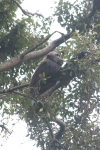
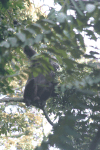
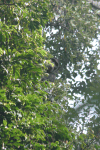

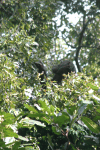
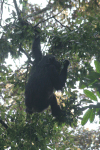
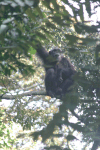
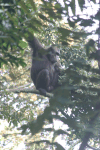
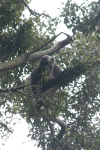
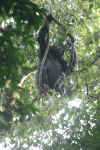

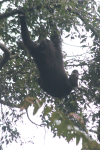
In the afternoon on my day in Nyungwe, I booked another trek, this time to see the Ruwenzori Black-and-white Colobus (Colobus angolensis ruwenzori, german: Angola-Stummelaffe, french: Guéréza d'Angola), a subspecies of the Angola Colobus, restricted to the Albertine Rift, in which Nyungwe National Park is located. This is an easy walk, not really a trek, the Colobus are fairly close by and easy to reach. The main Colobus group is about 400 monkeys large, the largest group of arboreal primates in Africa. Only the Chinese Golden Monkeys form groups of similar size. I visited a sub group of about 40, that visit an area near the park ranger station. Strangely enough, the dominant monkey of the group is not a Colobus, it is a Schmidt's Red-tailed Monkey (Cercopithecus ascanius schmidti, german: Rotschwanzmeerkatze, french: Cercopithèque ascagne). Some guides say it is a Mona Monkey, or a hybrid, but it is easily distinguished as a Schmidt's Red-tailed Monkey by its bright white nose.
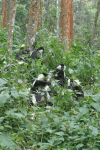
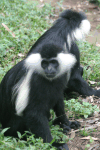
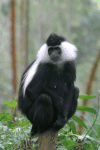
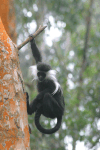
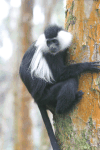
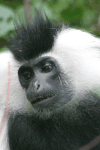

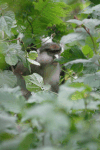
Following are a few pictures of the scenery around Nyungwe National Park, and of some of the plants and animals that I saw.

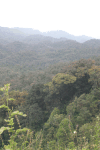
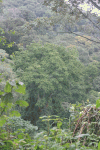
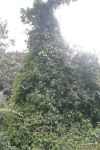

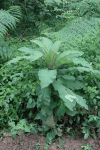
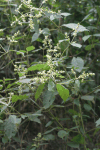


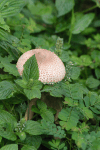
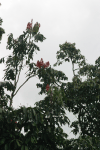



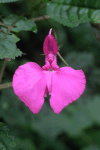
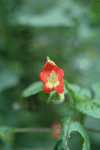

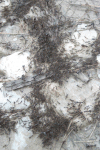
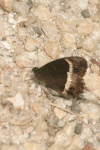

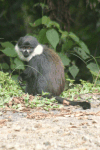
This page contains 41 pictures with 10 species
Page last updated on Wed Jan 26 17:07:32 2022 (Mountain Standard Time)
Page last updated on Wed Apr 24 19:16:55 2024 (Mountain Standard Time)
Rwanda - Nyungwe National Park on soaring.guenther-eichhorn.com